|
Group 6: Resource Management: Grand River Conservation
Introduction of the Grand River
Geographical information
(The Grand River Watershed, 2003)
- flowing 290km
- from the Dundalk Highlands to Lake Erie
- the Grand River watershed covers 7 000 sq. km
- the watershed is about 1 hr from Toronto and London along the Trans Canada Highway
|
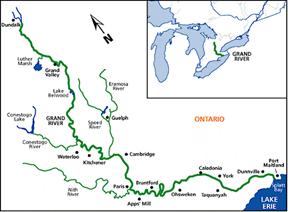
Map of Grand River Watershed (Friends of the Grand River, 2007) |
History
(The Grand River Watershed, 2003)
- there were man from about 11 000 years ago
- human activities facilitated a series of changes in climate, vegetation, soils, and wildlife
- a navigation canal was operated along the main river in the 19th century
- people and goods moved along the Grand
- in the late 19th and early 20th centuries, major floods occurred because of the serious deforestation
- diverse watershed land use (e.g. residential, industrial, agricultural…)
- the Grand is important for Canada, in terms of both natural and cultural
- human settlement and hence waste disposal with the low summer flow of the Grand
- à need of conservation
|

Map of Grand River watershed (Grand River Conservation Authority, 2007c)
|
Importance of the Grand
(The Grand River Watershed, 2003)
In 1994, the Grand was designated by the federal-provincial Heritage Rivers Board as one of Canada’s Heritage Rivers
|
Heritage Conservation
Natural Heritage Conservation
Aim:
- Maintain the ecosystem
- Preserve the stream channels and natural features
- Reserve the potential chemical and medical uses
- Provide recreation opportunity
Example:
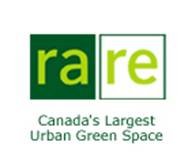
The Canada’s largest urban green spaces
--- rare Charitable Research Reserve
The Charitable Research Reserve rare (rare, 2005a)
rare Charitable Research Reserve, a non-profit organization established in 2002, owns a 370-hectare land reserve with a rich diversity of natural landscapes and wildlife habitats (rare, 2006).
1. Location
The 370-hectare nature reserve is located where the Grand and Speed Rivers meet, and rare is in the heartland of the Grand River watershed. It is the property of natural and agricultural landscapes that abuts the City of Cambridge, forming a large piece of green space separating the urban areas of Galt, Preston and Blair. |
2. High ecological value of rare Charitable Research Reserve:
Designation of Environmentally Sensitive Landscapes (ESL) (rare, 2007)
- 3610-arce Blair-Bechtel-Cruickston ESL in North Dumfries and Cambridge
- The 913 acres of rare lands make up a large portion of this ESL
- Almost all urban developments and a number of other activities that are harmful to the rural nature of this reserve are prohibited
 Rich biodiversity (rare, 2005a) Rich biodiversity (rare, 2005a)
- a wintering habitat for bald eagles
- one of the last places in Ontario that has old-growth Carolinian forest
- 55 rare and endangered species living there
- 201 species of birds are found on the property
- encompasses two Environmentally Sensitive Policy Areas
- consist of six different types of habitat, including alvars – a rare type of ecological zone that’s found in few places on Earth outside of the Great Lakes Basin.
Bald Eagle (
Source: rare (2005b)
|
3. The objectives of rare Charitable Research Reserve: (rare, 2005a)
- To preserve, protect, restore and improve the natural resources and wildlife habitat
- To encourage and promote public awareness of the natural resources, and the appreciation of their value in enhancing the quality of life.
- To facilitate research, seminars, interpretive activities, conferences and public forums about the flora, fauna, agricultural practices, hydrology and geology of the Region.
- To purchase, maintain and preserve historical buildings and archaeological sites in the Region
4. Environmental education
Guided Hikes and Walks
- Wildflower Hike
- Spring Migration Hike
Workshops - Bald eagle monitoring workshop
- Frogwatch workshop
Public Trail System
rare Administrative Office/Information Centre
- giving short lecture
- provides a general picture to the public about what the main job of rare is
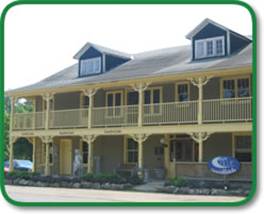
rare Information Centre (rare, 2005c)
|
Cultural Heritage Conservation
Aim:
- Preserve the local cultural character and its atmosphere
- Preserve the existing topography and traditional streetscape
- Preserve the buildings with distinctive architectural merits and historical values
Example:
St. Jacobs
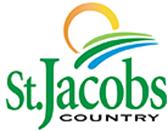 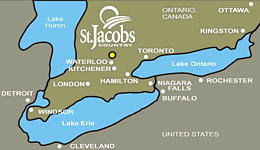
The location of St. Jacobs
(Mercedes Corp, 2006a)
Settlement (Nelson, 2003)
- St. Jacobs is located in southwest Ontario and north of Waterloo in Woolwich Township, Waterloo Region
- Pennsylvania-German Mennonites began to settle in St. Jacobs since 1790s
- The name of the town was changed from “Jacobstettel” to “St. Jacobs” in 1852
- Old Order Mennonites resist the use of modern technology, such as electricity and motor car, instead, they retain the old living style, such as traditional dressing and horse carts as main transportation mean
- But not all the Mennonites follow the traditional lifestyle as the Old Order Mennonites, for example, some of them begin to use mobile phone
Economics
- In the early years, Mennonites mainly relied on agricultural activities, for instance, mixed farming of grain, corn, feed crops as well as raising cattle
- In mid-1970s, St. Jacobs moved form a declining rural village to a famous tourism site because of its traditional and religious customs and lifestyles
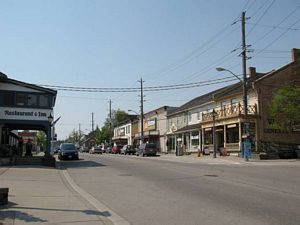
The old main street |
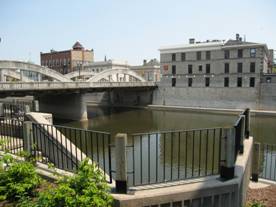
Grand River bank in Cambridge, Ontario
|
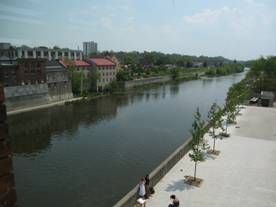
Grand River bank in Cambridge, Ontario
|
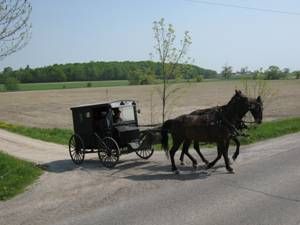
Mennonite in St. Jacobs
|
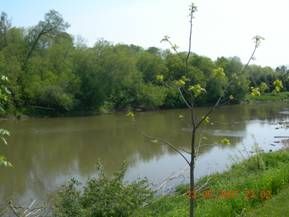
Grand River
|
Reference
Cooke, S. (2006). Water quality in the Grand River: A summary of current conditions (2000-2004) and long term trends. Cambridge: Grand River Conservation Authority.
Cruickston Charitable Research Reserve. (2007). About Cruickston. Retrieved June 20, 2007 from the World Wide Web: http://www.raresites.org/about.html
Grand River Conservation Authority (2005). Grand River Conservation Authority 2005 Fall Report. The Grand, pp.3-11.
Grand River Conservation Authority (2007a). The Grand River Watershed. Retrieved June 18, 2007 from http://www.sourcewater.ca/index/document.cfm?Sec=7&Sub1=0&sub2=0
Grand River Conservation Authority (2007b). Water supplies and water quality. Retrieved June 18, 2007 from http://www.grandriver.ca/index/document.cfm?Sec=67&Sub1=0&sub2=0
Grand River Conservation Authority (GRCA). (2007c). Conserving our future. Retrieved July 2, 2007 from the World Wide Web: http://www.grandriver.ca/Grca/pdf/GRCABrochure.pdf
Mercedes Corp.(2006a). Farmers' Markets. Retrieved June 20, 2007 from the World Wide Web: http://www.stjacobs.com/html/shopping-farmersmarkets.html
Mercedes Corp.(2006b). Maps. Retrieved June 20, 2007 from the World Wide Web: http://www.stjacobs.com/html/maps.html
Nelson, G. (2003). The Grand River Watershed. Waterloo: University of Waterloo.
Nicholas, Hill. (1984). Cambridge (Galt) --- a Heritage Conservation District Plan. Retrieved June 20, 2007 from the World Wide Web: http://www.city.cambridge.on.ca/planningdoc/main-street-HCDP.pdf
rare. (2005a). Save the land. Retrieved June 20, 2007 from the World Wide Web:
http://www.raretome.ca/cms/en/savetheland.aspx
rare. (2005b). Nurture Wildlife. Retrieved June 20, 2007 from the World Wide Web: http://www.raretome.ca/cms/en/nurturewildlife.aspx
rare. (2005c).Contact Us. Retrieved June 20, 2007 from the World Wide Web: http://www.raretome.ca/aspx/public/contact/contact.aspx?menuid=16
rare. (2006). A Registry of Accomplishments and Commitments, 2005. Retrieved June 26, 2007 from the World Wide Web:
rare. (2007). The rare review (Spring / Summer 2007). Cambridge: rare Charitable Research Reserve.
The Friends of the Grand River (2007). Maps. Retrieved June 22, 2007 from http://www.friendsofthegrandriver.com/map.htm
Wikipedia. (2007). St Jacobs Market. Retrieved June 20, 2007 from the World Wide Web: http://en.wikipedia.org/wiki/Image:St_Jacobs_Market.jpg
|
|